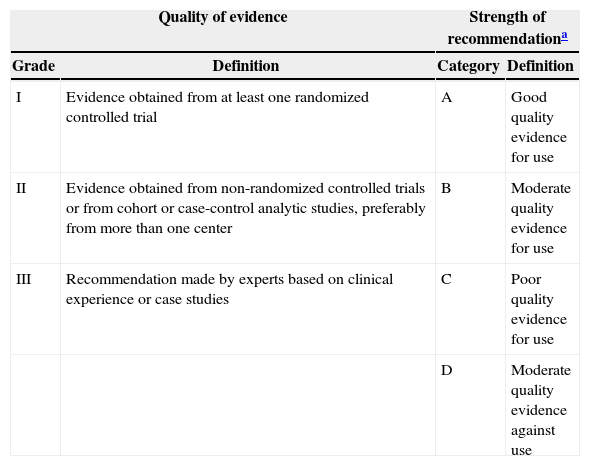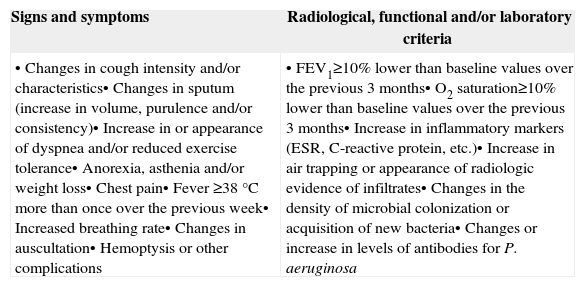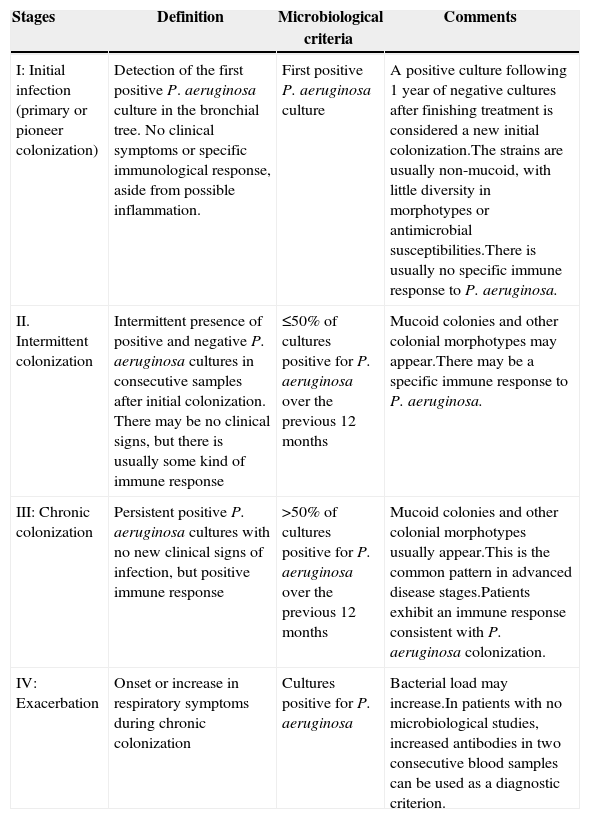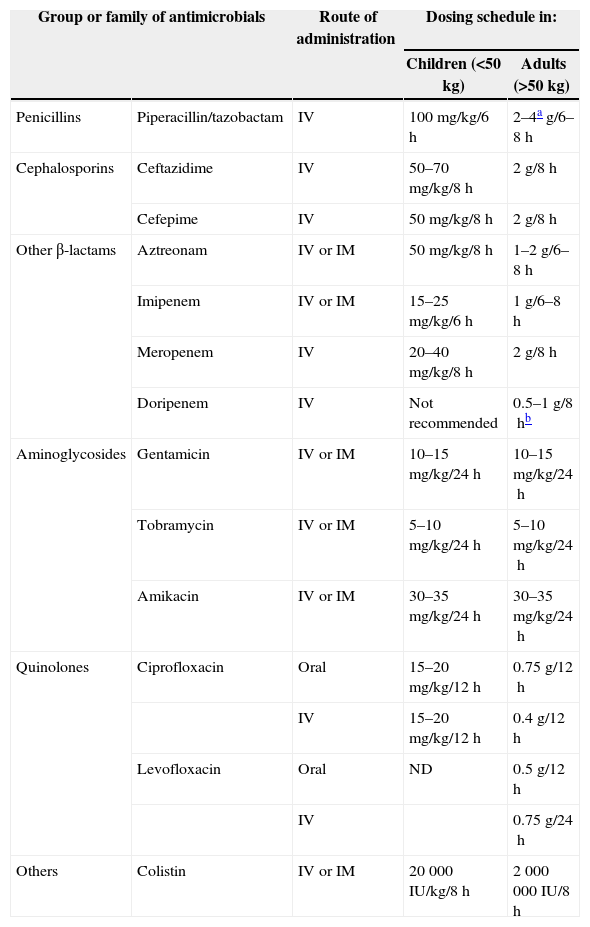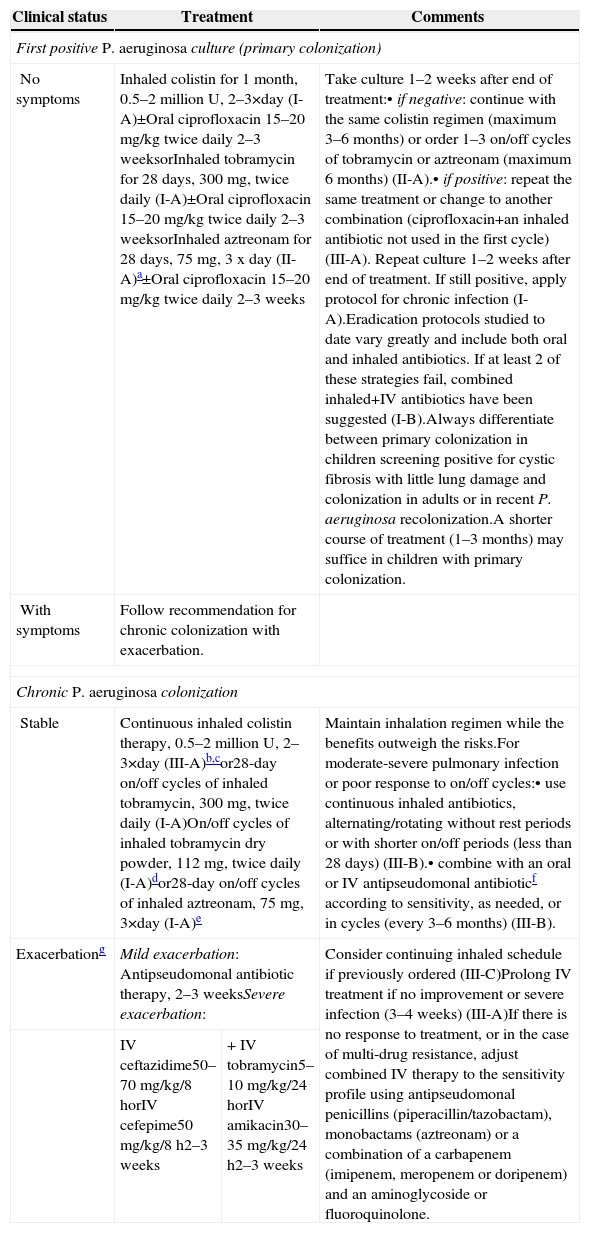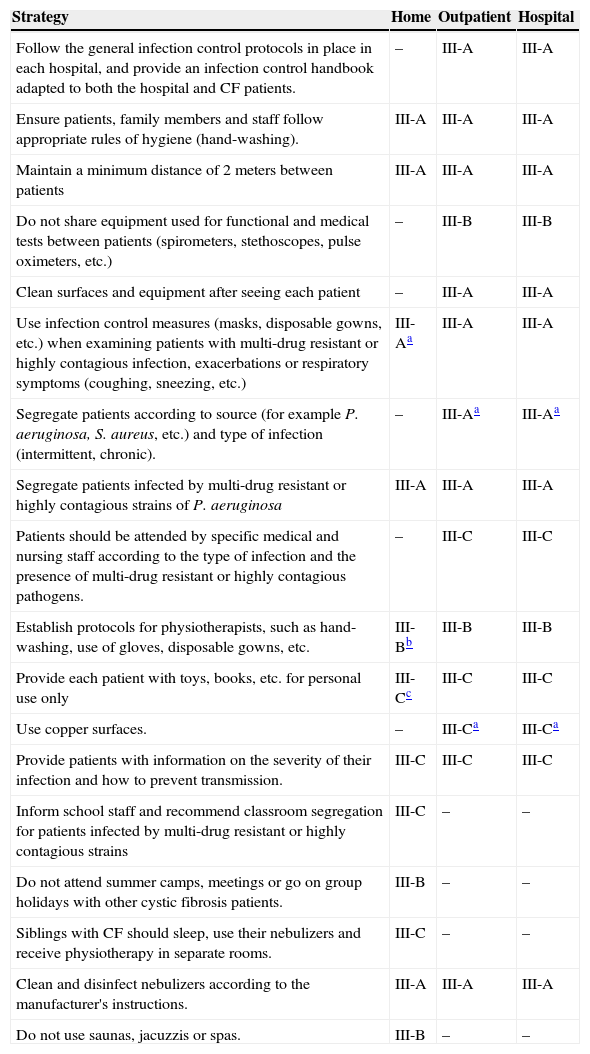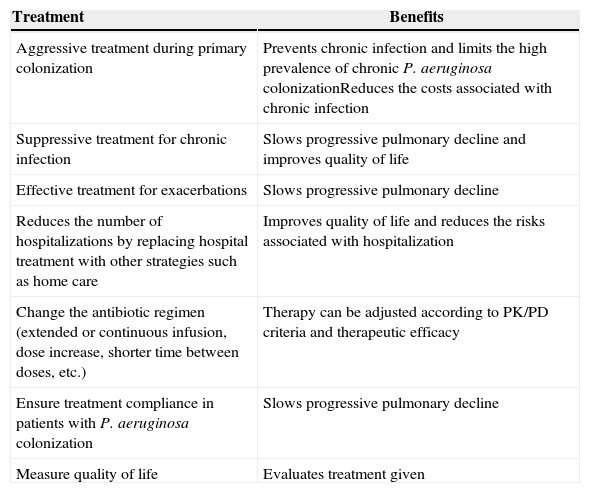Pseudomonas aeruginosa is the main pathogen in bronchopulmonary infections in cystic fibrosis (CF) patients. It can only be eradicated at early infection stages while reduction of its bacterial load is the therapeutic goal during chronic infection or exacerbations. Neonatal screening and pharmacokinetic/pharmacodynamic knowledge have modified the management of CF-patient. A culture based microbiological follow-up should be performed in patients with no infection with P. aeruginosa. At initial infection, inhaled colistin (0.5–2MU/tid), tobramycin (300mg/bid) or aztreonam (75mg/tid) with or without oral ciprofloxacin (15–20mg/kg/bid, 2–3weeks) are recommended. In chronic infections, treatment is based on continuous administration of colistin or with a 28-day on–off regimen with tobramycin or aztreonam. During mild-moderate exacerbations oral ciprofloxacin (2–3weeks) can be administered while serious exacerbations must be treated with intravenous combination therapy (beta-lactam with an aminoglycoside or a fluoroquinolone). Future studies will support rotation and/or new combination therapies. Epidemiological measures are also recommended to avoid new P. aeruginosa infections and cross transmission of this pathogen.
Pseudomonas aeruginosa es el patógeno más importante en la infección broncopulmonar en fibrosis quística (FQ). Solo se erradica en la infección inicial, mientras que la reducción de su carga bacteriana es el objetivo terapéutico en la infección crónica y exacerbaciones. El cribado neonatal y la farmacocinética/farmacodinámica han cambiado el manejo del paciente con FQ. Se debe realizar un seguimiento microbiológico en los pacientes sin infección por P. aeruginosa. En la infección inicial se recomienda tratamiento inhalado (28días) con colistina (0,5-2MU/8h), tobramicina (300mg/12h) o aztreonam (75mg/8h) con o sin ciprofloxacino oral (15-20mg/kg/12h, 2-3 semanas). En la infección crónica se recomienda solo vía inhalada en tratamiento continuo con colistina, o en ciclos on-off de 28días con tobramicina o aztreonam. Durante las exacerbaciones leves-moderadas se recomienda tratamiento oral (ciprofloxacino, 2-3 semanas) y en las graves tratamiento intravenoso (β-lactámico asociado a un aminoglicósido o una fluoroquinolona). Estudios futuros sustentarán la rotación y nuevas combinaciones de antimicrobianos. Se deben establecer también medidas epidemiológicas que eviten nuevas infecciones y la transmisión cruzada de P. aeruginosa.
The management and evolution of cystic fibrosis (CF) patients are directed by the presence of Pseudomonas aeruginosa (PA) bronchial colonization. In 2005, the Spanish Consensus Group for Antimicrobial Therapy in the CF Patient published a consensus document on the use of antibiotics to treat P. aeruginosa colonization in CF.1 It was the first report to consider the pharmacokinetics (PK) and pharmacodynamics (PD) of treatment strategies and the dynamics of bacterial infection in CF. The publication of additional recommendations,2–6 neonatal screening programs,7 the authorization of new antibiotics for CF8,9 and new scientific developments10–19 have prompted us to update our earlier report. Recommendations have been graded according to their level of evidence20 based on studies published in PubMed and weighted according to clinical experience (Table 1).
Levels of Clinical Evidence.20
| Quality of evidence | Strength of recommendationa | ||
|---|---|---|---|
| Grade | Definition | Category | Definition |
| I | Evidence obtained from at least one randomized controlled trial | A | Good quality evidence for use |
| II | Evidence obtained from non-randomized controlled trials or from cohort or case-control analytic studies, preferably from more than one center | B | Moderate quality evidence for use |
| III | Recommendation made by experts based on clinical experience or case studies | C | Poor quality evidence for use |
| D | Moderate quality evidence against use | ||
PA can be detected early by frequent bacterial culture of respiratory secretions.21–24 This is particularly useful in children screening positive for CF, as these patients are usually asymptomatic (III-A). Other useful strategies include monitoring patients for PA antibodies (III-B),25,26 polymerase chain reaction (III-B),27 and study of sputum for volatile organic compounds (III-C).28
The prevalence of PA colonization increases with age, and can be as high as 80% in patients aged >18 years.29–36 Persistently high bacterial load and the change from a non-fucoid to a mucoid morphotype correlate with more exacerbations, pulmonary decline and mortality.29,32,36 Exacerbations (Table 2) are characterized by changes in existing symptoms and the appearance of new symptoms.35,37,38
Criteria for Defining Exacerbations in Cystic Fibrosis Patients.36,38,39
| Signs and symptoms | Radiological, functional and/or laboratory criteria |
|---|---|
| • Changes in cough intensity and/or characteristics• Changes in sputum (increase in volume, purulence and/or consistency)• Increase in or appearance of dyspnea and/or reduced exercise tolerance• Anorexia, asthenia and/or weight loss• Chest pain• Fever ≥38°C more than once over the previous week• Increased breathing rate• Changes in auscultation• Hemoptysis or other complications | • FEV1≥10% lower than baseline values over the previous 3 months• O2 saturation≥10% lower than baseline values over the previous 3 months• Increase in inflammatory markers (ESR, C-reactive protein, etc.)• Increase in air trapping or appearance of radiologic evidence of infiltrates• Changes in the density of microbial colonization or acquisition of new bacteria• Changes or increase in levels of antibodies for P. aeruginosa |
Lung function can be normal in patients with primary PA infection. Initially, changes are observed in hyperinflation markers, such as residual volume (RV), RV/total lung capacity, and mesoexpiratory flows. Lung clearance index, a measure of inert gas washout using multiple-breath tests, detects minimal abnormalities, and is higher in patients with PA infection. Test results within normal limits have an excellent negative predictive value (93%) for ruling out PA infection (III-B).33,39–41
Reduced forced expiratory volume in 1s (FEV1) shows progression of the infection and is a good measure of the severity of exacerbations (III-A).42 Chest computed tomography (HRCT) provides early detection of airway decline and is useful in estimating severity (III-A).43–46 Lung infection is associated with increased air trapping and greater structural damage, including bronchiectasis.47 HRTC scores are worse in PA colonization29,48,49 and during exacerbations.50
Patterns of Infection and Microbiological EvaluationPulmonary infection in CF can be classified into 3 phases1:
- -
Initial colonization (primary colonization). Detection of the first positive PA culture in which non-mucoid, antibiotic-sensitive strains are usually isolated. A negative culture after the first positive culture can indicate an aborted initial colonization, cryptic colonization, or eradication of PA following antibiotic therapy. PA is considered eradicated when negative results are obtained from at least 2 cultures: 1 taken 1–2 weeks following completion of treatment and another 2–4 weeks later.51
- -
Intermittent colonization. This is indicated by intermittent positive and negative results from consecutive cultures after an initial infection. It can indicate permanent low-grade colonization, sample heterogeneity (different origins), or apparently transient eradication with colonization persisting in the sinuses, causing intermittent reinfection.3,52 Different strains are isolated, including mucoid morphotypes.
- -
Chronic infection. Common in CR patients with advanced disease. Mucoid colonies with a variety of other morphotypes are found as a result of specialization and adaptation of PA to the endobronchial environment. The causes of exacerbations are still unclear, but they usually coincide with increases in bacterial load or the emergence of antigenic variants.
Table 3 shows the patterns of infection defined in 20051 and updated according to the Leeds criteria and correlated with clinical parameters (II-A).53,54
Microbiological Patterns and Criteria in Pulmonary Pseudomonas aeruginosa Colonization/infection in Cystic Fibrosis Patients.1,53,54
| Stages | Definition | Microbiological criteria | Comments |
|---|---|---|---|
| I: Initial infection (primary or pioneer colonization) | Detection of the first positive P. aeruginosa culture in the bronchial tree. No clinical symptoms or specific immunological response, aside from possible inflammation. | First positive P. aeruginosa culture | A positive culture following 1 year of negative cultures after finishing treatment is considered a new initial colonization.The strains are usually non-mucoid, with little diversity in morphotypes or antimicrobial susceptibilities.There is usually no specific immune response to P. aeruginosa. |
| II. Intermittent colonization | Intermittent presence of positive and negative P. aeruginosa cultures in consecutive samples after initial colonization. There may be no clinical signs, but there is usually some kind of immune response | ≤50% of cultures positive for P. aeruginosa over the previous 12 months | Mucoid colonies and other colonial morphotypes may appear.There may be a specific immune response to P. aeruginosa. |
| III: Chronic colonization | Persistent positive P. aeruginosa cultures with no new clinical signs of infection, but positive immune response | >50% of cultures positive for P. aeruginosa over the previous 12 months | Mucoid colonies and other colonial morphotypes usually appear.This is the common pattern in advanced disease stages.Patients exhibit an immune response consistent with P. aeruginosa colonization. |
| IV: Exacerbation | Onset or increase in respiratory symptoms during chronic colonization | Cultures positive for P. aeruginosa | Bacterial load may increase.In patients with no microbiological studies, increased antibodies in two consecutive blood samples can be used as a diagnostic criterion. |
Treatment of PA infection is essential for controlling progression of respiratory disease. PA is rarely eradicated once chronic infection has set in, so the best treatment strategy is early prevention (I-A). Inhaled antibiotics are the treatment of choice in PA colonization in view of the particular niche in which it thrives, its tendency to form biofilms, and the inability of some oral or intravenous antibiotics to reach effective concentrations in the respiratory mucosa.9,18,55–58 This strategy can also help prevent the development of drug resistance, although it is important to monitor for the emergence of opportunistic infection from other bacteria.
Standard preparations specifically designed for this route of administration are recommended, as these are less likely to cause local adverse effects (mainly bronchospasm) (III-A).
The blood pharmacokinetics of antibiotics, meanwhile, differ from those of non-CF patients,17,61–63 and for this reason systemically administered doses (for example, during exacerbations) are not the same as those given to non-CF patients (Table 4), and have an impact on the antibiotic's PK/PD index of efficacy.58–60,64–72
Recommended Dose and Route of Administration of Antibiotics to Treat Exacerbations Due to Pseudomonas aeruginosa Colonization in Cystic Fibrosis Patients.
| Group or family of antimicrobials | Route of administration | Dosing schedule in: | ||
|---|---|---|---|---|
| Children (<50kg) | Adults (>50kg) | |||
| Penicillins | Piperacillin/tazobactam | IV | 100mg/kg/6h | 2–4ag/6–8h |
| Cephalosporins | Ceftazidime | IV | 50–70mg/kg/8h | 2g/8h |
| Cefepime | IV | 50mg/kg/8h | 2g/8h | |
| Other β-lactams | Aztreonam | IV or IM | 50mg/kg/8h | 1–2g/6–8h |
| Imipenem | IV or IM | 15–25mg/kg/6h | 1g/6–8h | |
| Meropenem | IV | 20–40mg/kg/8h | 2g/8h | |
| Doripenem | IV | Not recommended | 0.5–1g/8hb | |
| Aminoglycosides | Gentamicin | IV or IM | 10–15mg/kg/24h | 10–15mg/kg/24h |
| Tobramycin | IV or IM | 5–10mg/kg/24h | 5–10mg/kg/24h | |
| Amikacin | IV or IM | 30–35mg/kg/24h | 30–35mg/kg/24h | |
| Quinolones | Ciprofloxacin | Oral | 15–20mg/kg/12h | 0.75g/12h |
| IV | 15–20mg/kg/12h | 0.4g/12h | ||
| Levofloxacin | Oral | ND | 0.5g/12h | |
| IV | 0.75g/24h | |||
| Others | Colistin | IV or IM | 20000IU/kg/8h | 2000000IU/8h |
IV: intravenous; IM: intramuscular; ND: not defined.
There is no evidence to support the effectiveness of administering antibiotics before initial PA colonization, nor of PA vaccination, so these strategies are not recommended (I-A).73,74
Primary InfectionEarly treatment of primary PA colonization slows the development of chronic colonization (I-A). Treatment should be started as soon as the bacterium is isolated, as the eradication rates are very high (63%–100%).42,75–81 There are various eradication protocols, none of which have been shown to be clearly superior (I-A).3,55,82 Differences in design, in the definition of eradication, and in antibiotic treatment, make it difficult to compare studies published to date.79 Primary colonization is usually asymptomatic; however, if it debuts as an exacerbation, standard treatment regimens are recommended (III-A).
Twice-daily colistimethate sodium, taken together with oral ciprofloxacin for periods ranging from 3 weeks to 3 months,83,84 was the first antibiotic to have a significant effect on chronic infection. In Spain, this drug is marketed under the brand names GES® (Genéricos Españoles Laboratorio) and Promixin® (Praxis Pharmaceutical).
Inhaled tobramycin (300mg/5ml/12h) (TNS, TOBI®, Novartis) is also a safe and effective therapy for eradication of PA, and can even be used in children aged from 6 months to 6 years.78,80,85,86 The ELITE80 study compared the safety and efficacy of TNS (300mg/5ml) for 28 and 56 days following the first PA-positive culture, finding both strategies to be similar. Over 90% of patients tested negative for PA after 1 month of treatment, and most (69%) remained infection-free at 27 months follow-up. These and other studies suggest that short-duration (1–3 months) inhaled antimicrobials should be the treatment of choice (II-A).79,84–86
In the EPIC85 study, patients (aged from 1 to 12 years) were randomized to different treatment regimens for 18 months: combined TNS and oral ciprofloxacin cyclically every 3 months or placebo, or combined TNS plus oral ciprofloxacin or placebo only when 3-monthly sputum culture was positive for PA. TNS (300mg/5ml) was given in 28 days on/28 days off cycles for 18 months, and ciprofloxacin or placebo was administered for 14 days. No significant differences were observed between groups, suggesting that the addition of oral ciprofloxacin does not improve the efficacy of inhaled TNS.
Taccetti et al. in a study comparing TNS (300mg/5ml or 300mg/4ml) with inhaled colistin (2 MU/12h) for 28 days, both in combination with oral ciprofloxacin, found that neither regimen was clearly superior.79
Recently, the ALPINE study of aztreonam lysine for inhalation (AZLI, Cayston®, Gilead), 75mg/8h for 28 days, to treat primary colonization in patients aged between 3 months and 18 years showed that 89.1% of patients were negative for PA at the end of treatment, and that 75.2% and 58.2% remained free of infection at 28 days and 6 months, respectively, after the end of treatment.87
In the light of these studies, inhaled antibiotic treatment with colistimethate sodium (0.5–2 MU, 2 or 3×day) should be given for 1 month (I-A), or TNS (300mg/12h) for 28 days (I-A), or AZLI (75mg/8h) (II-A), either as monotherapy or in combination with oral ciprofloxacin (15–20mg/kg/12h) (maximum 2g/day), for 2–3 weeks (Table 5). Based on the analysis of microbiological tests, combination therapy with ciprofloxacin improves antibiotic action.89
Antimicrobial Treatment for Pseudomonas aeruginosa Bronchial Colonization in Cystic Fibrosis Patients According to Their Clinical Status. (Inhaled Antimicrobials Are Listed in Chronological Order of Their Use in Spain, not in Order of Recommendation.).
| Clinical status | Treatment | Comments | |
|---|---|---|---|
| First positive P. aeruginosa culture (primary colonization) | |||
| No symptoms | Inhaled colistin for 1 month, 0.5–2 million U, 2–3×day (I-A)±Oral ciprofloxacin 15–20mg/kg twice daily 2–3weeksorInhaled tobramycin for 28 days, 300mg, twice daily (I-A)±Oral ciprofloxacin 15–20mg/kg twice daily 2–3 weeksorInhaled aztreonam for 28 days, 75mg, 3 x day (II-A)a±Oral ciprofloxacin 15–20mg/kg twice daily 2–3 weeks | Take culture 1–2 weeks after end of treatment:• if negative: continue with the same colistin regimen (maximum 3–6 months) or order 1–3 on/off cycles of tobramycin or aztreonam (maximum 6 months) (II-A).• if positive: repeat the same treatment or change to another combination (ciprofloxacin+an inhaled antibiotic not used in the first cycle) (III-A). Repeat culture 1–2 weeks after end of treatment. If still positive, apply protocol for chronic infection (I-A).Eradication protocols studied to date vary greatly and include both oral and inhaled antibiotics. If at least 2 of these strategies fail, combined inhaled+IV antibiotics have been suggested (I-B).Always differentiate between primary colonization in children screening positive for cystic fibrosis with little lung damage and colonization in adults or in recent P. aeruginosa recolonization.A shorter course of treatment (1–3 months) may suffice in children with primary colonization. | |
| With symptoms | Follow recommendation for chronic colonization with exacerbation. | ||
| Chronic P. aeruginosa colonization | |||
| Stable | Continuous inhaled colistin therapy, 0.5–2 million U, 2–3×day (III-A)b,cor28-day on/off cycles of inhaled tobramycin, 300mg, twice daily (I-A)On/off cycles of inhaled tobramycin dry powder, 112mg, twice daily (I-A)dor28-day on/off cycles of inhaled aztreonam, 75mg, 3×day (I-A)e | Maintain inhalation regimen while the benefits outweigh the risks.For moderate-severe pulmonary infection or poor response to on/off cycles:• use continuous inhaled antibiotics, alternating/rotating without rest periods or with shorter on/off periods (less than 28 days) (III-B).• combine with an oral or IV antipseudomonal antibioticf according to sensitivity, as needed, or in cycles (every 3–6 months) (III-B). | |
| Exacerbationg | Mild exacerbation: Antipseudomonal antibiotic therapy, 2–3 weeksSevere exacerbation: | Consider continuing inhaled schedule if previously ordered (III-C)Prolong IV treatment if no improvement or severe infection (3–4 weeks) (III-A)If there is no response to treatment, or in the case of multi-drug resistance, adjust combined IV therapy to the sensitivity profile using antipseudomonal penicillins (piperacillin/tazobactam), monobactams (aztreonam) or a combination of a carbapenem (imipenem, meropenem or doripenem) and an aminoglycoside or fluoroquinolone. | |
| IV ceftazidime50–70mg/kg/8horIV cefepime50mg/kg/8h2–3 weeks | + IV tobramycin5–10mg/kg/24horIV amikacin30–35mg/kg/24h2–3 weeks | ||
IV: intravenous.
A follow-up culture should be taken 1–2 weeks after the end of the eradication therapy.52,88,90–92 If the culture is negative, TNS or AZLI should be prolonged for between 1 and 3 on/off (28-day) cycles (maximum 3–6 months), or 3–6 months uninterrupted colistimethate (II-A). If the culture is positive, the original regimen should be repeated, or a new regimen (ciprofloxacin in combination with an inhaled antibiotic not previously used) should be ordered (III-A). Cultures should be repeated at the end of the second cycle. If positive, the chronic infection protocol should be applied (I-A), with at least 1 follow-up culture every 3 months (III-A).
There is no conclusive data defining the number of times eradication cycles should be repeated following initial treatment failure. If PA persists after the second eradication attempt, an alternative strategy, such as combination inhaled and intravenous antibiotics (I-B) or the chronic infection protocol (I-A), could be used.3 The appearance of a positive culture after 1 year of negative cultures should be treated as a new initial colonization event (III-A).
Chronic InfectionLong-term antibiotic therapy has been shown to be effective against chronic PA colonization (I-A),92 inhalation being the route of choice (I-A).10,93 Comparative studies in inhaled antibiotics are limited insofar as they do not usually include patients not previously treated with the study drugs.
Colistimethate sodium with no antibiotic-free rest periods has been shown to be effective (III-A).2,94 The usual dose in adults is 0.5–2MU, 2–3×day, and in children 1MU, 2–3×day. However, this dose can be halved with some nebulizers. In a trial comparing TNS vs colistimethate sodium, most patients had previously received colistimethate. In both groups, the PA colony count fell significantly, although only the TNS group showed significant improvement in lung function.95
Colistimethate in dry powder (Colobreathe®, Forest Laboratories) (125mg/12h) is indicated in patients aged over 6 years with chronic PA colonization,72 and has been shown to be safe and equally effective as TNS. TNS (300mg/5ml/12h) in 28-day on/off cycles significantly improves FEV1, and reduces PA density in sputum, the number of hospitalizations, need for intravenous antibiotics and number of exacerbations (I-A),57,96 even in patients with mild-moderate lung infection.96 It also improves quality of life. A recent study has suggested that it can reduce mortality in patients with chronic infection.97 Tobramycin is also available in a new, more concentrated nebulized formulation (Bramitob®, Chiesi) with the same posology (300mg/4ml), thereby effectively reducing nebulization time.98
A dry powder formulation of tobramycin has recently been approved (TIP™, TOBI® Podhaler®, Novartis). The efficacy and tolerability of the powder form are similar to that of TNS, although a higher incidence of coughing has been reported.99,100 It is available in 112mg doses (4/28mg capsules/12h), in 28-day on/off cycles.
AZLI (75mg/8h in 28-day on/off cycles) has recently been introduced for patients aged 6 years or more (I-A).58,101 AZLI was shown to be superior to TNS (300mg/5ml) for a number of different parameters.102 Treatment was followed by an open-label extension period in which patients received 3 courses of AZLI. Improvements were comparable to those obtained during the initial 6-month trial.
In conclusion, several different therapeutic options for treating chronic bronchial infection are available, including continuous inhaled colistimethate sodium, or 28-day on/off cycles of TNS or AZLI (Table 5). Evidence that most of the benefits obtained during the treatment phase are not maintained during rest periods57,58,102 has led to the development of other regimens, including continuous inhaled antibiotics, alternating or rotating regimens, or even shortened cycles (for example, 14-day on/off cycles) (III-A).103 Combinations have been shown to be effective both in vitro and in animal models104 and are currently at the clinical trial stage; it is hoped they will limit the development of drug resistance.
Inhaled antibiotics should preferably be administered using the same nebulizers as tested in the clinical trials (III-A). The most common side effect is bronchospasm, so a fast-acting bronchodilator should be administered prior to inhalation. Patients receiving ototoxic or nephrotoxic inhaled antibiotics should be monitored once a year for kidney and auditory function.
ExacerbationsExacerbations increase the risk of mortality and are associated with a decline in respiratory function and quality of life. Despite its importance, no definition of exacerbation in CF has yet been agreed.105,106 It is generally accepted that a patient presenting 2 or more of the signs and symptoms indicated in Table 2 should receive antimicrobial treatment (III-A).1,105,107 Symptoms can be less evident in infants and preschool children.
Although the choice of empirical treatment is usually based on a sensitivity analysis of the most recent respiratory sample, in vitro sensitivity does not always correlate with response to treatment (III-A). Traditionally, 2 antimicrobials with different mechanisms of action have been used to enhance antibiotic action and restrict the selection of resistant mutants. Guidelines recommend, albeit on the basis of insufficient evidence, the use of dual therapy in severe exacerbations and in patients with more severe pulmonary infection1,4 (III-C). In mild to moderate exacerbations, treatment should start with oral ciprofloxacin (15–20mg/kg/12h, 2–3 weeks) (III-B).106 In the case of severe exacerbations, or when oral therapy has failed, a combination of an antipseudomonal beta-lactam (piperacillin/tazobactam, ceftazidime, cefepime, aztreonam, imipenem, meropenem or doripenem) and an aminoglycoside (usually tobramycin) or a fluoroquinolone is usually recommended (II-B).105,106 These drugs should be used in high doses due to their limited ability to penetrate respiratory secretions, and because the renal clearance of some antimicrobials, particularly aminoglycosides, is particularly rapid in CF patients.60,64,108
Intravenous colistimethate sodium has also been shown to be effective (III-A)2,108 although kidney function must be monitored. This antibiotic is usually reserved for multi-drug resistant strains, or when the usual treatment options have failed. There is insufficient evidence to recommend withdrawal or continuation of inhaled antibiotics in patients receiving the same antibiotic intravenously,4 although the risk of increased toxicity must be considered (III-C). Exacerbations should not be treated solely with inhaled antibiotics (III-D).
There is insufficient evidence to recommend continuous infusion of beta-lactams; therefore, intermittent cycles should be the norm (II-C).4 In the case of children, once-daily aminoglycosides should be given (B-II) to reduce the risk of kidney damage.109 There is no evidence to define the dosage regimen in adults. When receiving these drugs, patients must be monitored for serum levels and kidney function (III-A). Patients receiving frequent cycles of aminoglycosides should be monitored for auditory function (III-A).
Although there is insufficient evidence to determine the duration of exacerbation therapy,110 it should be continued until symptoms resolve and lung function returns to previous levels (III-C). This usually occurs within 2 weeks,111 except in the case of multi-drug resistant PA or severe pulmonary infection, where prolonged treatment is required.
Home intravenous therapy improves quality of life and can be more cost-effective (III-A); it should be chosen on the basis of the patient's circumstances and the resources available.112 Chest physiotherapy should be stepped up during exacerbations, and existing chronic therapies should be maintained (III-A).4
InflammationThe typical initial intense inflammatory response of the airways in CF patients, directed toward limiting infection, is ultimately harmful to the patient.113 Early administration of anti-inflammatory agents could limit the effects of this reaction and slow pulmonary decline.114 The strategies used in this case are:
- •
Macrolides. Macrolides modulate cytokine production, inhibit bacterial protein synthesis, attenuate bacterial virulence factors and impair biofilm formation.115,116 Oral azithromycin is the drug of choice, although studies are needed on its long-term effect, above all in children diagnosed by neonatal screening.31 It should be used in patients aged over 6 years with PA colonization, and should be given once daily (10mg/kg in patients weighing <40kg or 500mg in patients weighing >40kg) 3 times/week for at least 4–6 months (I-B).6,92,117,118 It should not be given in the presence of nontuberculous mycobacteria, as macrolides are part of the treatment of this disease. If nontuberculous mycobacteria are detected during macrolide therapy, administration should be discontinued to avoid induced resistance. All patients should undergo a QT study at the start of treatment, with at least once yearly follow-up studies (III-B).
- •
Ibuprofen. High-dose ibuprofen improves chest radiograph scores and nutritional status, reduces the number of hospitalizations, and significantly improves FEV1.118–121 Although associated with side effects,121,122 ibuprofen is indicated in children >6 years not receiving nephrotoxic drugs120 and with an FEV1>60%92 (I-C). There is no evidence for subjects <6 years.92
- •
Systemic corticosteroids. These control the action of inflammatory bronchial cells.123 Long-term (4 years) prednisone every other day (1–2mg/kg) slows pulmonary decline and improves, albeit temporarily, spirometry values,123 particularly in children with mild pulmonary disease.114,124 It is, however, associated with significant side effects, and the benefits have only been shown to outweigh the risks in allergic bronchopulmonary aspergillosis, intractable bronchospasm, severe small airways disease and terminal disease. Non-enteric-coated tablets are preferable (I-C).92,114
- •
Inhaled corticosteroids. No prospective, randomized, placebo-controlled studies have shown these to be beneficial in CF patients, and as such, they should not be routinely used.92,125 They are only recommended in patients with documented bronchial hyperresponsiveness (I-C). They inhibit the inflammatory action of bronchial epithelial cells and slow FEV1 decline, although they are associated with side effects.126–128
The importance of delaying the appearance of PA colonization calls for the adoption of strategies to prevent primary infection and disease transmission among CF patients (III-A). The source of PA is largely unknown, although some environmental reservoirs have been identified, particularly warm, damp places. PA is not found in the ocean, as high salt levels would inhibit growth of the bacterium. Showers and swimming pools containing chlorinated water are usually safe, although hydrotherapy pools and jacuzzis can harbor bacteria. PA is often found in hospitals, particularly in ICUs, although the risk of infection is low if appropriate precautions are taken. Nebulizers used by patients with chronic colonization do not usually harbor PA129 although contaminated healthcare equipment can cause cross-infection. PA is usually transmitted via direct contact, droplets or fomites. Non-mucoid PA can survive for 24h on inanimate surfaces, and the mucoid strain can survive for 48h, and even as long as 8 days, in sputum left on a dry surface.130 To prevent droplet transmission, guidelines recommend maintaining a distance of at least 2 meters between patients, and the use of masks,19,131 although routine use is not recommended in all guidelines132 (III-C).
There is evidence of cross-infection in summer camps, meetings, doctors’ surgeries and hospitals; therefore, preventive measures should be taken in these settings (Table 6).129,133–136 New PA colonization, above all multi-drug resistant and highly contagious strains, should be monitored (III-A). PA genotyping should be performed to document transmission and study sources of infections (III-C).
Epidemiological Control Strategies in Different Settings for CF Patients With Pseudomonas aeruginosa Colonization.
| Strategy | Home | Outpatient | Hospital |
|---|---|---|---|
| Follow the general infection control protocols in place in each hospital, and provide an infection control handbook adapted to both the hospital and CF patients. | – | III-A | III-A |
| Ensure patients, family members and staff follow appropriate rules of hygiene (hand-washing). | III-A | III-A | III-A |
| Maintain a minimum distance of 2 meters between patients | III-A | III-A | III-A |
| Do not share equipment used for functional and medical tests between patients (spirometers, stethoscopes, pulse oximeters, etc.) | – | III-B | III-B |
| Clean surfaces and equipment after seeing each patient | – | III-A | III-A |
| Use infection control measures (masks, disposable gowns, etc.) when examining patients with multi-drug resistant or highly contagious infection, exacerbations or respiratory symptoms (coughing, sneezing, etc.) | III-Aa | III-A | III-A |
| Segregate patients according to source (for example P. aeruginosa, S. aureus, etc.) and type of infection (intermittent, chronic). | – | III-Aa | III-Aa |
| Segregate patients infected by multi-drug resistant or highly contagious strains of P. aeruginosa | III-A | III-A | III-A |
| Patients should be attended by specific medical and nursing staff according to the type of infection and the presence of multi-drug resistant or highly contagious pathogens. | – | III-C | III-C |
| Establish protocols for physiotherapists, such as hand-washing, use of gloves, disposable gowns, etc. | III-Bb | III-B | III-B |
| Provide each patient with toys, books, etc. for personal use only | III-Cc | III-C | III-C |
| Use copper surfaces. | – | III-Ca | III-Ca |
| Provide patients with information on the severity of their infection and how to prevent transmission. | III-C | III-C | III-C |
| Inform school staff and recommend classroom segregation for patients infected by multi-drug resistant or highly contagious strains | III-C | – | – |
| Do not attend summer camps, meetings or go on group holidays with other cystic fibrosis patients. | III-B | – | – |
| Siblings with CF should sleep, use their nebulizers and receive physiotherapy in separate rooms. | III-C | – | – |
| Clean and disinfect nebulizers according to the manufacturer's instructions. | III-A | III-A | III-A |
| Do not use saunas, jacuzzis or spas. | III-B | – | – |
CF is associated with a high consumption of health resources: the longer the survival rate, the greater the cost of the disease.137 A number of studies have focused on the pharmacoeconomics of CF, evaluating the severity of infection, the long-term nature of the disease, the cost of laboratory studies, healthcare including hospitalization, and the different therapies required.137–142 In Spain, direct costs are especially: drugs (45%), visits to the doctor (19%), hospitalization (17%) and laboratory and other studies (12%).142 Overall, PA infection increases these costs by 40%–55%,137,141 the highest being associated with chronic patients and women.141 Given the circumstances, economic analyses of the cost-effectiveness, cost–benefit and cost–usefulness of PA therapies are particularly important (Table 7), although these can be affected by the market price of different over-the-counter drugs.
Keys to Cost-effective Treatment of Pseudomonas aeruginosa Colonization in Cystic Fibrosis Patients.
| Treatment | Benefits |
|---|---|
| Aggressive treatment during primary colonization | Prevents chronic infection and limits the high prevalence of chronic P. aeruginosa colonizationReduces the costs associated with chronic infection |
| Suppressive treatment for chronic infection | Slows progressive pulmonary decline and improves quality of life |
| Effective treatment for exacerbations | Slows progressive pulmonary decline |
| Reduces the number of hospitalizations by replacing hospital treatment with other strategies such as home care | Improves quality of life and reduces the risks associated with hospitalization |
| Change the antibiotic regimen (extended or continuous infusion, dose increase, shorter time between doses, etc.) | Therapy can be adjusted according to PK/PD criteria and therapeutic efficacy |
| Ensure treatment compliance in patients with P. aeruginosa colonization | Slows progressive pulmonary decline |
| Measure quality of life | Evaluates treatment given |
Treatment of PA infection is based on clinical evidence and experience with a small number of antimicrobial drugs. New formulations and antibiotics will soon be available in Spain (colistin dry powder, liposomal amikacin, levofloxacin solution and ciprofloxacin dry powder). These could pave the way for new treatment regimens, including combination therapy, rotation and alternating cycles. The overall aim is to reduce the number and frequency of exacerbations, prevent the development of drug resistant strains, slow the rate of lung function decline, and reduce the need for oral antibiotics during rest periods in on/off cycles. Researchers are currently studying nebulizers that can facilitate administration of these drugs and improve treatment adherence. Other lines of research include the use of anti-inflammatory drugs and their effect on infection, the search for biomarkers, and the study of the cost–benefit ratio of different therapeutic alternatives. Finally, therapies designed to enhance the action of CFTR143 may change the way in which antimicrobial drugs are used to treat PA colonization in CF patients.
FundingThe research carried out by R. Cantón, A. Oliver, L. Martínez-Martínez into cystic fibrosis and P. aeruginosa was co-financed by the Instituto de Salud Carlos III (Spanish Ministry of the Economy and Competitiveness) (ref. PI12/00734 and PI12/00103) and the European Development Regional Fund “A Way to Achieve Europe,” through the Red Española de Investigación en Patología Infecciosa (REIPI RD12/0015).
Conflict of InterestsR. Cantón has taken part in training programs sponsored by AstraZeneca, Gilead, Novartis and Praxis Pharmaceutical and has conducted research projects for Astra-Zeneca; L. Maize has taken part in advisory committees and training programs sponsored by Chiesi, Gilead, Novartis, Praxis and Vertex; A. Scribing has taken part in training activities sponsored by Chiesi, Novartis and Praxis and has been a member of Gilead advisory committees; C. Olveira has taken part in advisory committees and training programs sponsored by Gilead, Novartis, Praxis and Vertex; A. Oliver has conducted research projects sponsored by Gilead; O. Ascension has taken part in training programs sponsored by Chiesi, Gilead, Novartis and Praxis and in advisory committees and research projects funded by GSK and Novartis; S. Gartner has taken part in training programs sponsored by Chiesi, Gilead, Novartis, Praxis and Vertex; E. Roma has taken part in training programs sponsored by Gilead, Novartis and Praxis; E. Quintana-Gallegos has taken part in advisory committees and training programs sponsored by Gilead, Novartis and Praxis; R. Groin has taken part in training programs sponsored by Chiesi, Gilead, Novartis and Praxis; M.I. Barrio has taken part in training programs sponsored by Chiesi, Gilead, Novartis, Praxis and Vertex; M.D. Pastor has taken part in training programs sponsored by Gilead; C. Prados has taken part in training programs sponsored by Gilead, Novartis and Praxis; J. Barber has taken part in training programs sponsored by AstraZeneca and Gilead; L. Martínez-Martínez has taken part in training programs and research projects sponsored by Astra-Zeneca, GSK, Janssen-Cilag, MSD and Pfizer; C. Vázquez has taken part in training programs sponsored by Gilead, Novartis, Praxis and Vertex; J. de Garcia has taken part in advisory committees and training programs sponsored by Chiesi, Gilead, Novartis and Praxis; A. Sole has taken part in training programs sponsored by Gilead, Novartis, Vertex and Praxis. A. Salved, M.T. Martinez-Martinez, J.J. Castón and J.L. Poveda have no conflicts of interest.
Please cite this article as: Cantón R, Máiz L, Escribano A, Olveira C, Oliver A, Asensio O, et al. Consenso español para la prevención y el tratamiento de la infección bronquial por Pseudomonas aeruginosa en el paciente con fibrosis quística. Arch Bronconeumol. 2015;51:140–150.
Spanish Consensus Group for Antimicrobial Treatment in the Cystic Fibrosis Patient (SEFQ), Infectious Diseases and Clinical Microbiology (SEIMC), Pediatric Pulmonology (SENP), Pulmonology and Thoracic Surgery (SEPAR), Chemotherapy (SEQ) and Hospital Pharmacy (SEFH).


